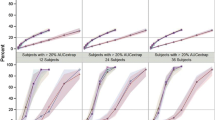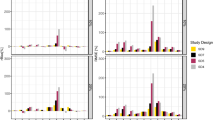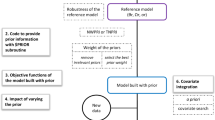Abstract
Pharmacokinetic data consist of drug concentration measurements, as well as reports of some measured concentrations being below the quantification limit of the assay (BQL). A pharmacokinetic model may be fit to these data, and for this purpose, the BQL observations must be either discarded or handled in a special way. In this paper, seven methods for dealing with BQL observations are evaluated. Both single-subject and population data are simulated from a one-compartment model. A moderate amount of data is simulated for each individual. The actual cv of concentration measurements at the quantification limit is assumed to be no greater than 20%, in accord with the FDA Guidance. The results of this paper should be interpreted in this context. The methods include handling BQL observations as fixed-point censored observations, i.e., by using the likelihoods that these observations are in fact BQL. This method is shown to have some overall statistical advantage. However, the gain in using this method over that of simply discarding the BQL observations is not always much, and this is especially so when the frequency of BQL observations is small. Some simple methods entailing (i) replacing one or more BQL observations with the value 0, or (ii) replacing them with the value QL/2, where QL is the quantification limit, are also included. The first of these two approaches should not be used. With population data, use of the second approach can result in some noticeably improved estimation of the typical value of a parameter, but then there is also marked degradation in the estimation of the population variance of the parameter.
Similar content being viewed by others
REFERENCES
J. D. Kalbfleisch and R. L. Prentice. The Statistical Analysis of Failure Time Data. Wiley, New York, 1980.
Guidance for Industry: Bioanalytical Methods Validation for Human Studies. U.S. Dept. of Health and Human Services, Food and Drug Administration, Center for Drug Evaluation and Research, 1998.
J. Lu, J. M. Gries, D. Verotta, and L. B. Sheiner. Selecting reliable pharmacokinetic data for explanatory analyses of clinical trials in the presence of possible non-compliance. J. Pharmacokin. Pharmacodyn. 28:343–363 (2001).
R. Jennrich. Asymptotic properties of nonlinear least-square estimators. Annals Math. Stats. 40:633–643 (1969).
S. L. Beal. Adaptiυe M estimation with independent nonidentically distributed data. Ph.d. Thesis, University of California at Los Angeles, 1974.
S. L. Beal and L. B. Sheiner. NONMEM Users Guide Part VII—Conditional Estimation Methods. NONMEM Project Group, San Francisco, 1992–1998.
S. L. Beal and L. B. Sheiner. NONMEM Users Guides (I-VIII). NONMEM Project Group, San Francisco, 1989–1998.
N. L. Johnson and S. Kotz. Continuous Uniυariate Distributions—1. Houghton Mifflin, Boston, 1970.
B. Hoadley. Asymptotic properties of maximum likelihood estimators for the independent not identically distributed case. Annals Math. Stats. 42:1977–1991 (1971).
D. J. Finney. Probit Analysis. Cambridge University Press, 1971.
D. R. Cox. Analysis of Binary Data. Methuen, London, 1970.
Author information
Authors and Affiliations
Rights and permissions
About this article
Cite this article
Beal, S.L. Ways to Fit a PK Model with Some Data Below the Quantification Limit. J Pharmacokinet Pharmacodyn 28, 481–504 (2001). https://doi.org/10.1023/A:1012299115260
Issue Date:
DOI: https://doi.org/10.1023/A:1012299115260




